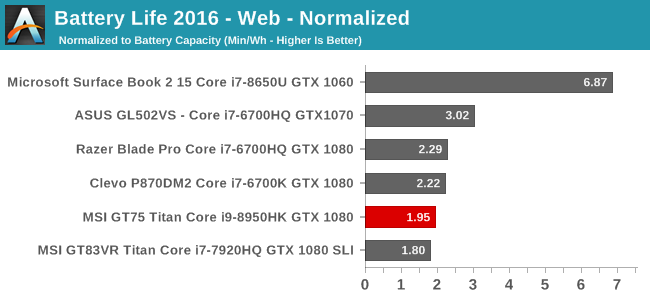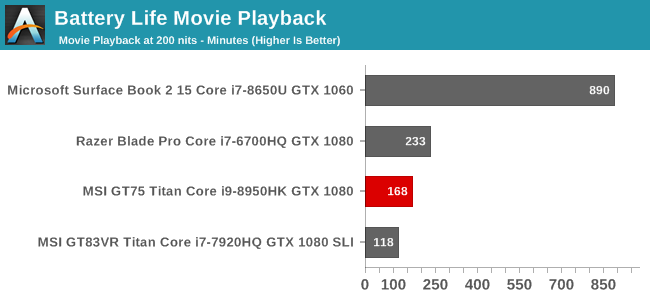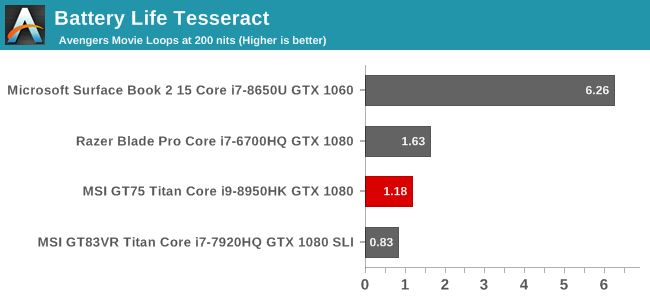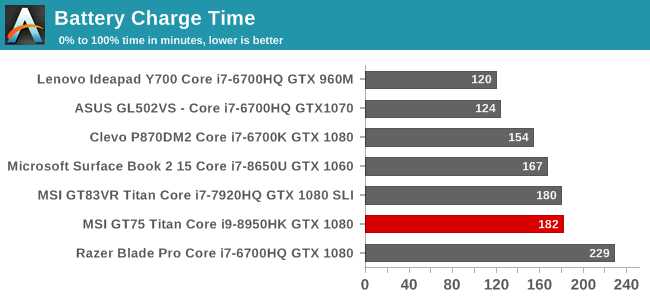The MSI GT75 Titan Laptop Review: Hex-Core DTR
by Brett Howse on September 13, 2018 9:00 AM EST- Posted in
- Laptops
- Gaming
- MSI
- Pascal
- Coffee Lake
- Coffee Lake-H
Battery Life
On most systems, battery life is arguably one of the most important aspects, but a desktop replacement device like the MSI GT75 Titan is so large and so heavy that it’s unlikely to ever be used away from a desk. Also, these systems tend to offer high-performance components on the inside, and those generally mean high-power draw.
As such, the battery in any system like this is more or less a glorified uninterruptible power supply, unless you want to use it away from the plug for a really short time.
MSI does offer the GT75 Titan in two configurations. The base tier is a 75 Wh battery, and the top models come with a listed 90 Wh battery. We’ve got the top unit, so it should have a 90 Wh battery, although powercfg only lists the capacity at 79,344 mWh of capacity.
Update: MSI let us know that the review unit is an early model which came with the 75 Wh battery, and all new units come with the correct 90 Wh.
Battery Life – 2013 Light

Our older test has become too light for modern machines, but for now we’ve kept it due to the abundance of older devices that have data for it. Regardless, on a system like this the base power draw is so high that any light workload doesn’t really impact the results, so this is more or less the same as it would be at idle. At under three hours runtime, it’s not great.
Battery Life – 2016 Web

Our 2016 version of the test is much more demanding, which generally lowers the result quite a bit on a low-power device, but on a gaming system such as this, the base power draw masks almost any light load, so the result is almost exactly the same as the older test.
Normalized Results


Just as a note these calculations are done with the battery capacity listed at 80 Wh, rather than the 90 Wh on the spec sheet, because this system isn’t able to see the full 90 Wh. The normalized results remove the battery capacity from the equation, and show how many minutes you’ll get per Wh of battery. In this case, it’s not very good.
Digging into this a bit more, the base power draw of the system at idle was found to be between 25 and 30 Watts. That explains the poor battery life. Having a high-end six-core CPU paired with a beefy GPU that can’t be powered off is going to do this, of course.
Battery Life – Movie Playback

Amazingly the movie playback, which is generally the least demanding workload we test, was within one minute of the light battery test. So if you’re going to watch a movie on this laptop while unplugged from the wall, just be aware you’re going to get less than three hours of playback.

Our Tesseract score divides the movie playback time by the length of The Avengers, to get an idea of how many movies you can watch on this system. As you can see, it’s best to finish your popcorn before the first movie is over.
Charge Time
The MSI GT75 Titan comes with not one, but two 230-Watt power supplies, which connect into a Y connector and then into the laptop. The base model comes with a single 330-Watt model, and that would likely be enough for this system unless you were overclocking, which you can, so the two power supplies make sense.

The charge time isn’t amazing despite the huge amount of power available, but this isn’t a system that’s going to likely need to be charged quickly anyway.










48 Comments
View All Comments
ViRGE - Thursday, September 13, 2018 - link
Later on in the article, they mention that it's the new adapter based on Intel 9260, rather than the awful Qualcomm stuff. That may make it worth it. The worst part of Killer's stuff in recent years wasn't the software, it was the underlying hardware.Brett Howse - Thursday, September 13, 2018 - link
Yes the 1550 didn't exhibit any of the issues I've seen with the older model. I was pretty happy with it.PeachNCream - Friday, September 14, 2018 - link
In a roundabout way, this validates a number of complaints about earlier models of Killer Wireless products that were the subject of ire in previous articles. It's a shame that sort of acknowledgement wasn't around when previous generations were actually being sold. Also, this is the first time I've seen a Killer Wireless even get a bandwidth test in a while. Recent motherboards equipped with earlier model Killer WiFi cards didn't get any testing. I'm not trying to connect and conspiracy dots here, but the combination of facts doesn't paint a very rosy picture about the past couple years of Anandtech's view of Killer products and might add fuel to the fire of people like timecop1818 to continue to denounce Rivet Networks' claims as suspicious.Brett Howse - Friday, September 14, 2018 - link
You're mistaken I've reviewed plenty of laptops with Killer's previous model and every single time I said they had reliability issues. I think I've been pretty clear over the last couple of years that at this point there's Intel and no one else in terms of quality Wi-Fi. In fact I recently reviewed a laptop with the Qualcomm Wi-Fi that the Killer was based on and it had the exact same issues.PeachNCream - Friday, September 14, 2018 - link
That wasn't a call out of you in specific, but the tone of the site as a whole. In fact, I agree that you've noted stability problems and recommended driver updates in reviews of the Dell XPS 15 9560, the MSI GT83VR Titan 7RF, and Clevo P870DM2, and had a relatively slow result with a Razer Blade Stealth in March of 2016. (I didn't remember so I just checked and apologize for leaving you with the impression that I was slinging ire your way.)The lack of bandwidth testing is more a comment about motherboard reviews where there isn't much in the way of validation done with NIC performance, but there were some comments espousing the benefits of its presence. There have also been past product announcements that were promotional in nature. All of that was in the absence of analytical testing that proved the benefit of the Killer NIC's traffic prioritization, its key selling point. Mix that situation with the lingering ire Bigfoot/Rivet/whomever else has built over the years with customers and you've got a situation where people will get defensive or aggressive over being told they should find the product useful. None of that is something I think you've had a hand in. The problem is, or maybe was given the transition to Intel hardware and that the point is probably now moot, elsewhere.
pyrrh0 - Thursday, September 20, 2018 - link
I work with Wi-Fi and Apple's choice of Broadcom's kit in its laptops trumps anything I've used or heard about using Intel's WLAN gear.bennyg - Friday, September 14, 2018 - link
Eh, I had an issue a few years ago that was easily fixed by uninstalling the silly management software, killer wlan issues are overblown imoRedNeon - Friday, September 14, 2018 - link
Except that there already is a laptop with AMD Vega 56 GPU, the Acer Predator Helios 500.RedNeon - Friday, September 14, 2018 - link
Anandtech used to be good.Brett Howse - Friday, September 14, 2018 - link
Those were the days!